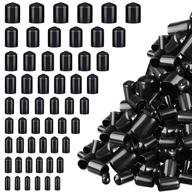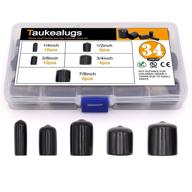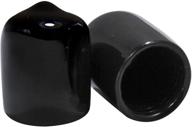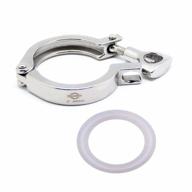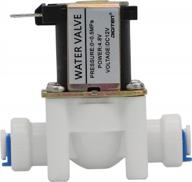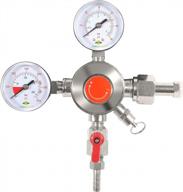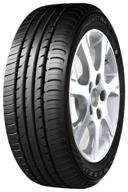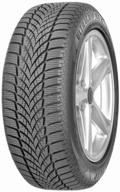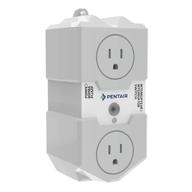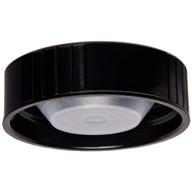Top products in 🔩 Protective Caps
Types of Protective Caps
Protective caps are essential components in hydraulic and pneumatic systems. They prevent contamination and damage by sealing off tubes, hoses, fittings, valves, and other components when not in use. There are several types of protective caps to choose from depending on your specific needs.
Push-On Caps
Push-on caps, also known as friction caps, are the most common type of protective cap. They use an interference or friction fit to securely seal components. Push-on caps are made of plastic or metal and feature a closed end and open cavity. Their flexibility allows them to be pushed on by hand and form a tight seal.
Thread Protectors
Thread protectors, also known as thread caps, screw onto threaded ports to protect the threads from damage. They prevent marring, scratches, corrosion, and debris buildup. Thread protectors are available in metal and plastic with various thread styles including NPT, BSPT, metric, and UN/UNF.
Pull-Off Caps
Pull-off caps secure to components using a friction fit but also have a tab, grip, or pull ring to assist with removal. The tab locks the cap in place but provides an easy way to detach the caps by hand. Pull-off caps are useful when components are recessed or hard to reach.
Dust Caps
Dust caps provide protection against dirt, debris, and other contaminants. They use a closed end design with small vent holes to equalize pressure while blocking particulate matter. Dust caps can be made of plastic, vinyl, or rubber materials. They are a low-cost option for basic protection.
Custom Caps
For unique applications, custom caps can be manufactured. Custom options include:
- Special sizes, shapes, and designs
- Branding or part numbers
- Various materials like PVC, rubber, silicone, etc.
- Venting configurations
- Attached tethers or chains
Work closely with a manufacturer to create caps tailored to your specific components and protection needs.
Summary
The right protective caps defend critical components from contamination while not in service. Consider the types of fittings present, environmental conditions, and potential issues like corrosion when selecting caps. Investing in quality caps reduces maintenance costs and prevents system failures.
Another interesting products
Benefits of Using Protective Caps
Protective caps are a simple but effective way to defend hydraulic and pneumatic systems from contamination and damage. Using proper protective caps provides numerous benefits that save time and money.
Prevent Leaks
Caps stop leaks from fittings, valves, and lines when disconnected. This prevents spills and hazards. For example, an industrial machine retrofit required disconnection of hydraulic hoses. Rubber dust caps prevented major fluid leaks during the downtime and reassembly.
Avoid Contamination
Caps keep contaminants out of systems. Particulates, dirt, moisture and other debris can enter open tubes and ports. This contamination causes wear, clogging, corrosion, and system failures. Dust caps on pneumatic tooling prevent grit and dust from entering clean air lines when stored.
Protect Threads
Thread protectors keep threaded ports safe from damage. Unprotected threads are prone to:
- Nicks and scratches
- Bending or cross-threading
- Rust and corrosion
Any thread damage can prevent proper sealing or installation of components down the line.
Extend Service Life
By keeping systems free of contaminants and damage while stored or transported, caps extend equipment lifetime. Clean components with protected fittings see less wear and operate more efficiently over a longer duration before needing to be replaced.
Simplify Maintenance
Since caps reduce contamination problems in systems, maintenance is needed less frequently. Less wear, leaks, clogging and damage makes system upkeep much easier and cheaper.
Using protective caps as a proactive measure saves untold costs and headaches down the road. Protect your investment by capping any exposed hydraulic or pneumatic components.
Protecting Hydraulic and Pneumatic Systems
Hydraulic and pneumatic systems require protection when not in use to prevent problems from contamination, corrosion, and physical damage. Implementing protective methods and devices helps maintain peak performance.
Seal Open Ports
Exposed ports allow contaminants to enter the system. Use proper caps and plugs to seal components like:
- Tubing ends
- Hose connections
- Manifold outlets
- Pipe threads
A machine shop uses vinyl dust caps to seal pneumatic tool ends during storage. This prevents metal shavings and particulates from entering clean air lines.
Secure Moving Parts
Prevent damage to extending cylinders and moving joints by restraining them from unexpected motion. Options include:
- Locking holding valves
- Counterbalance valves
- Blocking with brackets
A hydraulic lift table has safety chains installed to prevent uncontrolled collapse and jack damage if a hose bursts.
Absorb Vibration and Shock
Proper mounting and isolation from vibration can reduce component fatigue and failures. Use shock-absorbing tactics like:
- Flexible hoses and couplings
- Isolation pads and mounts
- Suspension systems
Server racks on a ship are mounted on pneumatic isolators to counteract wave motion and prevent downtime.
Apply Protective Coatings
Surface treatments protect against corrosion and wear. Common options include:
- Paints and powders
- Anodizing
- Chromate conversion
Hydraulic cylinder rods are chrome plated to resist pitting and rusting, extending service life.
With proper protection measures, hydraulic and pneumatic systems enjoy longer maintenance cycles, less downtime, and longer service lives.
Preventing Contamination and Damage
Contamination and damage pose serious threats to hydraulic and pneumatic systems. Particles, moisture, and corrosive chemicals can quickly degrade components. Physical impacts and improper handling also compromise function. Implementing good contamination control and damage prevention practices reduces operating costs and extends equipment lifetime.
Contamination Control
Contaminants in fluid systems cause erosion, corrosion, leaks, clogs, and premature wear. Methods to prevent contamination include:
- Using filtered air supplies and reservoirs
- Sealing components with caps and plugs
- Installing inlet screens and strainers
- Flushing and cleaning before assembly
- Using desiccant breathers on reservoirs
A cleanroom manufactures pneumatic valves with strict protocols to prevent particulate contamination.
Damage Prevention
Physical impacts, drops, crashes, and improper handling bend, dent, crack, and warp system components. Practices to avoid damage include:
- Bracing and blocking moving parts during transport
- Isolating systems from vibration or shock
- Avoiding impacts and abrasions
- Handling components with care
- Protecting external surfaces
Hydraulic pistons are shipped in custom foam lined cases to prevent nicks and dings.
Proper Maintenance
Regular maintenance helps catch contamination and damage issues early. Tasks include:
- Inspecting components for signs of wear
- Checking filter indicators
- Sampling fluids for particulates
- Checking for leaks
- Testing performance parameters
Scheduled maintenance flushes abrasive metal dust from an assembly plant's pneumatic system, preventing cylinder wear.
Stopping contamination and damage before it starts is the most effective method. With proactive prevention and maintenance, hydraulic and pneumatic system reliability greatly improves.
Materials for Protective Caps
Protective caps seal and shield hydraulic and pneumatic components from contamination and damage. Selecting the right cap materials for the application ensures proper protection and performance.
Metal Caps
Metal caps provide excellent durability and chemical resistance. Common metals include:
- Steel - strong, inexpensive, prone to rust
- Stainless steel - corrosion resistant for harsh environments
- Aluminum - lightweight, won't spark
- Brass - corrosion resistant, non-sparking
Stainless steel thread protectors on fire truck water pumps resist corrosion from foaming agents.
Plastic Caps
Plastic caps offer versatility at lower cost. Typical plastics used are:
- Polyethylene (PE) - flexible, chemical resistant
- Polyvinyl chloride (PVC) - durable, flame retardant
- Polypropylene (PP) - temperature resistant, stiff
- Nylon - weather/chemical resistant, heat tolerant
A factory uses polyethylene port plugs to seal hydraulic reservoirs when installing filtration modules.
Rubber Caps
Rubber caps provide flexibility for irregular shapes and accessibility. Compounds include:
- Natural rubber - good sealing, prone to age hardening
- Silicone - temperature resistant, maintains seal
- Neoprene - resistant to oils and chemicals
- VitonTM - expensive, resistant to aggressive fluids
Neoprene thread protectors safeguard pneumatic tool fittings from cutting fluids.
Other Materials
Less common options like PTFE, foam, or custom blends may suit unique applications. Consider environmental factors and fluid compatibility.
Choosing the optimal materials for protective caps ensures components stay clean and undamaged.
Similar products
Sizing and Custom Options for Protective Caps
Getting the right fit and features in protective caps is key to properly sealing components. Consider sizing needs and custom options when selecting caps.
Sizing
Correct sizing of caps prevents leaks, damage, and loose fits. Measure critical dimensions of the component ports when choosing caps:
- Diameter or thread size
- Length or depth
- Shape and orientation
Caps should fit snugly without too much force. Use calipers, gauges, or templates when possible. Allow a margin of error for any worn or damaged surfaces.
Customizing Caps
Standard caps may not suit unique equipment needs. Consider custom options like:
- Special materials - Fluid or chemical compatibility issues may dictate materials like PTFE, VitonTM, or specialty plastics.
- Unique shapes/sizes - Custom diameters, lengths, threads, and end forms fit non-standard component ports.
- Branding - Molded or printed logos help identify capped ports or contents.
- Color coding - Different cap colors by fluid or function improve organization.
- Venting - Small filtered vents equalize pressure without contaminant ingress.
A specialty hydraulic manifold has custom nylon caps 3D printed to fit unique stunted port protrusions.
Design Considerations
Factor in these design choices when selecting caps:
- Environmental exposure - temperature, chemicals, weather effects
- Fluid compatibility - oils, gases, water, etc.
- Component access and space constraints
- Cap retention methods - chains, tethers, clips
- Expected wear and replacement
Proper sizing and custom options create the perfect protective caps for any hydraulic or pneumatic system.
Top Brands and Product Recommendations for Protective Caps
When selecting protective caps, stick with reliable brands offering quality products. Here are top manufacturers and sample product recommendations.
Parker Hannifin
Parker offers protective caps and plugs for industrial and mobile systems:
- Shrader Valve Caps - brass caps seal tire valve stems
- Sta-tite Pipe Plugs - heavy duty pipe thread protectors
- QUICKClamp Hose Caps - tool-free push-on hose end caps
Eaton
Eaton provides caps for vehicle and hydraulic systems:
- Hose Repair End Caps - seal hose ends after crimping
- AEC Thread Protectors - metal dust caps with tether cables
- Brass Push-On Caps - friction fit brass caps
McMaster-Carr
McMaster-Carr stocks a wide selection of protective caps:
- Reusable Vinyl Hose Caps - flexible caps for air hoses
- Silicone Rubber Caps - waterproof protection for electrical connectors
- Quick-Release Dust Plugs - thumb latch retention for fast access
Amazon
Amazon provides every type of protective cap imaginable:
- Solac Plastic Push-On Caps - inexpensive poly caps
- Anning Vinyl Thread Protectors - multiple sizes and threads
- Flexible Rubber Dust Caps - tapered ends, reusable
Grainger
Grainger stocks heavy duty industrial protective caps:
- Steel Threaded Pipe Caps - durable reusable metal caps
- Conti Push-On Plastic Caps - ribbed grip PE caps
- Flexible PVC Hose End Caps - corrosion and chemical resistant
Trust top brands for well-designed, quality manufactured protective caps that get the job done right.
Benefits of Amazon Prime for Buying Protective Caps
When purchasing protective caps for hydraulic and pneumatic systems, Amazon Prime provides significant benefits that save time and money.
Fast Free Shipping
Amazon Prime offers free two-day shipping on millions of products. This allows you to get the protective caps you need quickly without paying extra shipping fees. Rapid fulfillment reduces downtime waiting for caps to arrive.
Free Returns
Amazon Prime members get free returns on most items. This makes it easy to exchange caps if you get the wrong size or material. Returns help ensure you get the right protective caps the first time without hassle.
Amazon Prime Try Before You Buy
Select products are eligible for Prime Try Before You Buy. This allows you to try caps for a week before committing to purchase them. It's a great way to test fit and performance before investing in larger quantities.
Access to Exclusive Deals
Amazon Prime members get 30 minute early access to Lightning Deals and other exclusive discounts. This means you can score protective caps for incredibly low prices before inventory sells out.
Amazon Customer Service
Get access to Amazon's legendary customer service resources as a Prime member. Talk to customer service reps by chat or phone whenever you need help with orders for protective caps.
Business Prime Shipping Benefits
Business Prime offers free same-day and next-day shipping for unlimited users. Companies can get caps delivered urgently when needed without added fees.
Overall, Amazon Prime provides the selection, convenience, and service to easily purchase quality protective caps. The shipping and return benefits make getting the right products hassle-free.
Keep Your Hydraulic And Pneumatic Systems Safe With Protective Caps.
Protective caps are essential for keeping hydraulic and pneumatic systems safe from damage and contamination. Essentra Components offers a range of protection caps that can be used in various applications, including hydraulic and pneumatic systems, automotive, and industrial applications. Caplugs provides caps to protect hydraulic or pneumatic fittings and other critical connections. They also offer custom protective cap solutions. Caplugs also offers protective caps and plugs that come in threaded or non-threaded options and multiple styles and materials. New-Line Hose and Fittings recommends dust caps and plugs for quick connects to prevent contamination from entering pneumatic or hydraulic systems. Amazon offers hydraulic coupler dust caps that keep couplers clean and protect hydraulic systems from the elements via quick coupler connections.






